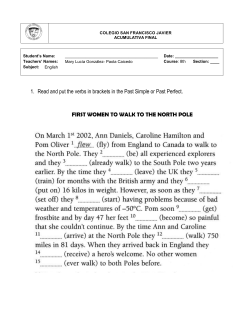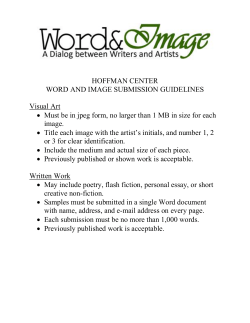
Week 12 Presentation | Heejo Choi.pptx
The case for decoupling assembly and submission standards to maintain a more flexible registry of biological parts RN Alnahhas, B Slater, Y Huang, C Mortensen, JW Monk, Y Okasheh, MD Howard, NR GoIel, MJ Hammerling, and JE Barrick Presented by Heejo Choi Week 12 | 2015 April 29 BioBrick’s Request for Comments (RFC) Process hosts discussions for the development of standards • BioBricks Founda=on manages the Registry of Standard Biological Parts o Submission standards – requirements on DNA sequence o Assembly standards – procedure to combine biological parts • RFCs communicate requests for new standards o Propose a standard o Describe protocols o Comment, extend, or replace previous RFC • 100+ RFCs documented today Current Standard: RFC 10 cons=tutes a combined assembly and submission standard • Parts must be flanked by prefix and suffix sequences containing restric=on enzyme sites for assembly • These illegal restric=on sites must not be present within the sequence Recent trends suggest a growing number of unreleased parts due to an illegal site • Data represents parts submiRed by July 29, 2013 • “suggest a significant and growing burden” to adhere RFC 10 Recent trends weakly suggest a growing number of unreleased parts due to an illegal site Number of unreleased parts with an illegal site 1000 RFC 10 800 Data represents parts submiRed by July 29, 2013 Adapted from Figure 1C 600 400 200 0 2002 2004 2006 2008 Year 2010 2012 2014 RFC 95 may alleviate the burden of removing illegal restric=on enzyme sites prior to part submission • ~1850 par=cipants (iGEM 2013 Annual Review) • < 3% survey par=cipa=on RFC 95 proposes a submission standard decoupled from assembly • Homing endonucleases recognize (and cleave) longer target sequences o Less likely to find illegal sites within the Part • RFC 95 can be backwards compa=ble with RFC 10 o Flanking current restric=on enzyme sites with homing endonuclease sites Assump=ons The group’s claims rest on the following assump,ons: • Field is currently limited by the number of available parts o Perhaps expanding number of available parts is not the limi=ng factor o True challenge is defining the quality, characteriza=on, and documenta=on of parts (Kwok 2010) • Transi=on from RFC 10 to RFC 95 is larger than implied o RFC 95 is not always backwards-‐compa=ble with RFC 10 o Illegal sites within the part must s=ll be removed o Majority of teams use restric=on enzyme cloning methods Concerns and Sugges=ons Concerns: • Survey data rests on < 3% response • Paper may be ahead of its =me (field is not limited by the number of available parts) Sugges,ons: • • • • Acquire more data points for survey (Figure 2) Clarity of how data in Figure 1C Consider mandatory ques=onnaire for a representa=ve random pool Ask direct ques=ons: o “Would your team prefer to use RFC 95 as the standard rather than RFC 10?” o “Does your team feel the Registry needs more standard parts?” Significance of data cura=on & informa=on accessibility • Registry of Standard Biological Parts is ever growing o Philosophy of “Get, Give & Share” • Standardiza=on ensures compa=bility of parts when crea=ng longer, more complex parts • Cura=on process is limited by quality part characteriza=on o Exemplified by diverse degree of detail for logic gate entries in SynBioLGDB Significance of an=cipa=ng change “For a gene=c parts repository and registry to remain relevant as technology progresses, it should an=cipate these changes and adapt its methods to complement them.” Future Work • RFC 98 (rapid assembly of RFC 10 compa=ble parts in a single reac=on) • RFC 104 (rapid assembly of RFC 10 parts without using restric=on enzymes) The Backstory from M. Hammerling (2012 UT Aus=n iGEM Team) • SubmiRed parts were rejected due to illegal sites • “While we made it to the interna=onal compe==on at MIT that year, the team was unwilling to completely re-‐engineer a perfectly func=onal and well-‐characterized biological part to comply with what we viewed as an arbitrary sequence constraint. This limited how much success we were able to achieve at the interna=onal level that year. ” • “…introduce a new submission standard that would fix this problem and allow teams to focus on developing novel, useful parts rather than muta=ng the sequences of their parts to comply with the current submission standard.” U=lizing homing endonuclease sites reduces the probability of encountering a illegal site within part • Restric=on enzyme sites (6-‐8 bp) • Homing endonuclease sites (15-‐30 bp) Part Length (bp) P(illegal site in part) 1 RBS 12 2-‐3% 2 Terminator 129 4-‐12% 9 GFP 720 50% Most used rank from Top 10 Most Used Parts on the Registry (hRp://parts.igem.org/Frequently_Used_Parts)
© Copyright 2025











